Cottonwood/Sedona
Where to start the day posed something of a problem as many of the locations I wanted to visit don't open until 8. I ended up heading out on Sycamore Canyon Road. Although they are some distance away at the start, you quickly notice the rocks that contain Sycamore Canyon. I did some car birding on the way, starting with a American Kestrel at the edge of Clarkdale. On Sycamore Canyon Road, I added Violet-green Swallow, Cliff Swallow, Ash-throated Flycatcher, and Lark Sparrow to the trip list.
Sycamore Canyon
I climbed down into the Sycamore Canyon Wilderness on the Parson's Trail. The trail quickly drops about 150' or so to the creek (Sycamore Creek). After that, you walk along the creek, with only limited elevation change. I understand that the canyon opens up some farther down, but I only walked about 1 1/3 miles down the creek. At times, there are nice views of the canyon walls. The creek has plenty of water, and there is lush vegetation along it. There are also birds!
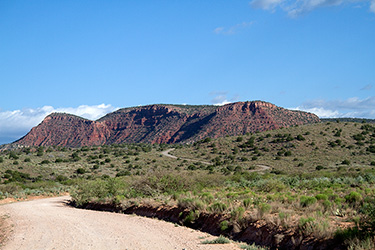 |
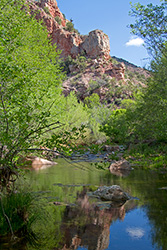 |
| Sycamore Canyon Wilderness | Sycamore Creek |
|---|
As soon as I got to the creek level, I found a gorgeous Audubon's Warbler. While I was looking a the Audubon's, a duck flew by. I was too late to ID it. I also heard a Belted Kingfisher calling as it flew along the creek. Pretty soon, a Canyon Wren started calling. I heard them on and off throughout the walk, but never did spot one. A couple of Empidonax remain unidentified, but a couple also called—Dusky Flycatcher. I also heard the big “whit” of a Brown-crested Flycatcher in various places, but didn't see any other than as a bird flitting away. I caught up with one later at Bubbling Ponds.
There were a lot of Western Tanagers present. When I spotted a red tanager, I assumed it would be a Summer Tanager, but the head pattern revealed a surprise—Hepatic Tanager. This is not their habitat, so it must be a migrant. A couple of small birds flitting around were very hard to get a good look at. When I finally did, they turned out to be Warbling Vireos, just at the point another one broke into song. On my way back, I encountered a Bridled Titmouse. With some backtracking for birding, I ended up walking about 2.8 miles according to the GPS.
Mingus Mountain
On the way back to Clarkdale I noticed a kingbird. It was rather hard to catch up with, but turned out to be Cassin's Kingbird. At Clarkdale, I took US-89A toward Mingus Mountain. I stopped at a scenic overlook on the way, which goes through the very vertical old mining town of Jerome. Unfortunately, this turned out to be a bad day to try to bird Mingus Mountain. It was a windy day, and very windy up on the mountain, making birds hard to come by. I did see some Chipping Sparrows and Western Bluebirds, and a Steller's Jay called near Mingus Lake, but mostly the birds were quiet and the wind cold, so I didn't stay long. On the way back I was surprised to see the snow-capped San Francisco Peaks in the distance. The snow up there may pose a problem later if I decide to hike Humphrey's Peak (on the itinerary for early June).
Page Springs Area
I decided the Page Springs area would be a good choice on a windy day, and drove back through Clarkdale and Cottonwood to get there. I didn't know about the Bubbling Ponds Fish Hatchery, but saw the IBA sign and stopped there. I was greeted by a noisy Great-tailed Grackle. A couple of Mallards were on the ponds, and a Black Phoebe was active there. A mulberry tree was getting a lot of activity, and I added Black-headed Grosbeak to the list. Phainopeplas and Western Tanagers were all over. A small bird in a tangle turned out to be a House Wren. I also added Western Wood-Pewee on the way out. As I walked back along the trail, a Black-chinned Hummingbird buzzed by; some cardinal-like chips led to a pair of Northern Cardinals; and a gray bird flitting around was a Lucy's Warbler. Just before I got back in the car, I noticed a different swallow, Barn Swallow. I also spotted a Western Kingbird as I drove off to Page Springs Fish Hatchery, which is just across the creek. The birds there were pretty much the same, but I did add Song Sparrow.
Montezuma Castle and Well
The next stop was Montezuma Well. This is a unit of the Montezuma Castle National Monument. The “well” was formed by the collapse of a limestone cavern, and contains a first magnitude spring. The Sinagua indians lived here, and built an irrigation ditch from the spring to water their crops. There's a trail down into the “well”, and you can see where the water disappears into the rock. There's also a trail on the outside to the beginning of the old canal. I added my first lizard of the trip: Desert Grassland Whiptail. (I've actually seen at least 3 species of lizard on the trip, but the others moved away too fast to ID.)
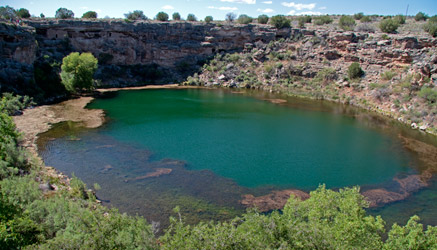 |
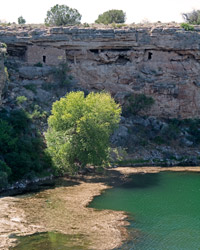 |
| Montezuma Well | Cliff Dwellings |
|---|---|
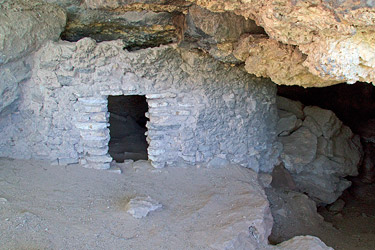 |
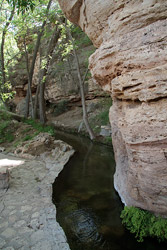 |
| Ruin at Montezuma Well | Outlet Canal |
| Wildflowers | |
|---|---|
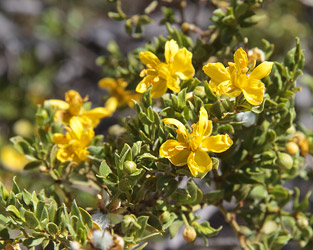 |
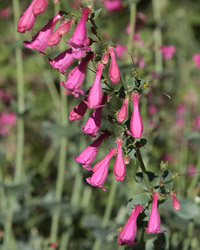 |
| Creosote Bush | Desert Penstemon |
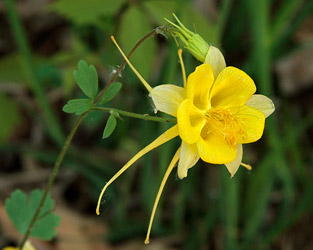 |
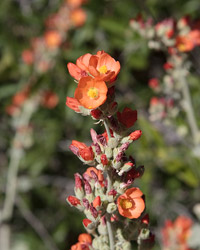 |
| Golden Columbine | Globemallow |
By now it was past 3:30, and the other national monuments here close at 5. The closest was Montezuma Castle itself, and that became my last stop of the day. The castle is a large cliff dwelling. One of the current occupants of that cliff is the Cliff Swallow. Many of their nests were visible below an overhang, and they could sometimes be seen flying in and out.
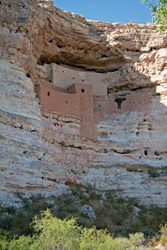 |
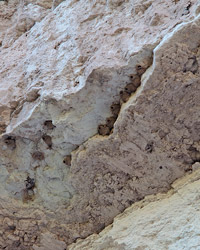 |
| Montezuma Castle | Cliff Swallow Nests |
|---|
A Rock Squirrel was feeding on some grass and Creosote Bush flowers, seeming oblivious to all of us photographing it at close range. Pretty soon, someone in the crowd that formed spotted a chipmunk—Cliff Chipmunk.
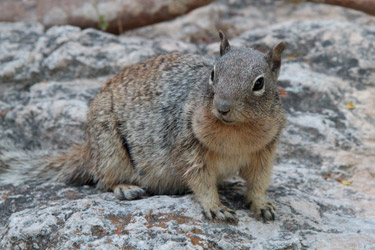 |
|
| Rock Squirrel | |
|---|---|
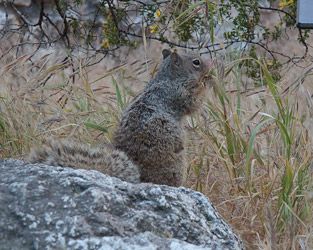 |
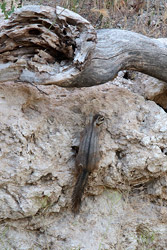 |
| Rock Squirrel | Cliff Chipmunk |
I was done at 4:30. There wasn't time to visit Tuzigoot, which also closes at 5, maybe tomorrow. It had been a long day, so I grabbed a quick sandwich for dinner. The plan tomorrow is to start early at Dead Horse Ranch State Park, which I can get in early, then visit Tuzigoot before hitting the road.
So far, I have 53 species of bird and 3 mammal species for the trip.
Best Western, Cottonwood, AZ